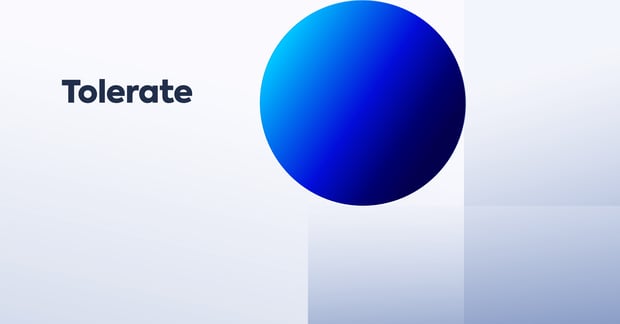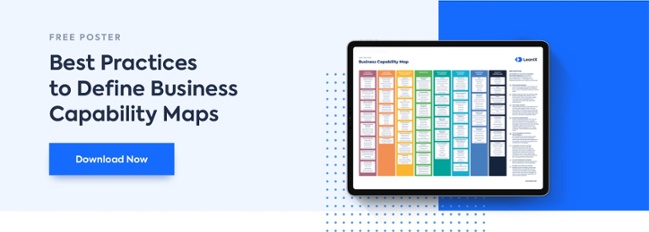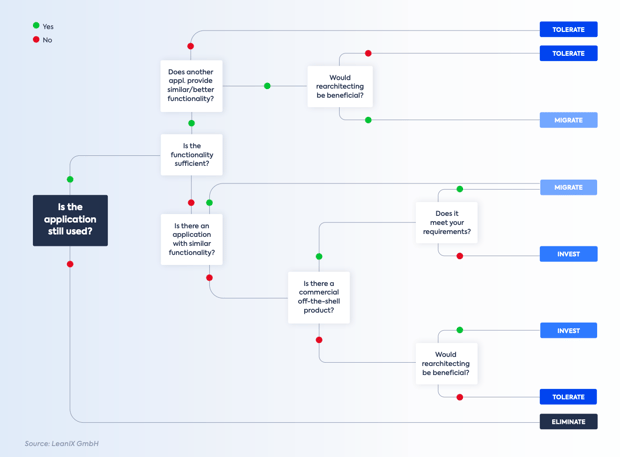
The Gartner® TIME framework is the best-practice methodology for enterprise architects carrying out an application rationalization initiative. Let's explore the first stage in this four-part process: Tolerate.
The Gartner® TIME framework remains an essential part of any application rationalization initiative. The model involves deciding what to do with each application by assigning it to one of four categories:
This sounds simple in theory, as all the best methodologies do, but the practice can be far more complex. For example, before you can start putting applications in buckets, you need a clear view of your entire application portfolio, including how applications map to business capabilities. It's the pre-requisite for any informed decisions regarding which applications have which destinies within your organization.
Getting such a view of your application portfolio, however, can be far from straightforward. For example, organic growth can leave applications without clear ownership, and removing the wrong application can be like pulling out the wrong block in a game of Jenga.
That's where the LeanIX enterprise architecture management (EAM) platform comes in.
The LeanIX EAM Platform For Application Rationalization
Our platform simplifies the process of acquiring data on all your applications. This data can then be displayed in a scalable, visual format to make it digestible to all stakeholders.
To find out more about how the LeanIX platform empowers application rationalization decisions, see our application rationalization page:
USE CASE: Application Portfolio Assessment & Application Rationalization
This is the first in a series of four articles in which we will look more closely at the Gartner® TIME framework. In this first part we will look at the first classification: Tolerate.
Before we do, however, let's consider how these four markers fit into the model as a whole.
An Overview Of The Gartner® TIME framework
The Gartner® TIME framework has been standard practice for enterprise architects conducting application rationalization for some time now. The TIME model focuses on assessing all of the applications used within your organization in terms of their technical fit for your environment and functional fit for your business.
In the model, technical fit refers to applications that have:
- good service levels
- low risk
- maintainability
- a lack of reliance on application experts
- information quality and format
- architecture alignment
- etc
Business value, of course, equates to how the application maps to your business capabilities and needs. For support with mapping your business capabilities, download our free business capability map:
If an application is a poor technical fit, yet it's important for your business, it's worth exploring alternative software that may be a better fit. On the other hand, no matter how good an application is, if it's not any use to your business, then it might not be worth continuing to spend money on.
Lastly, the Gartner® TIME framework, as well as being an acronym, is fitting in actually considering the future. Applications can often become outdated or fall out of support over time. As such, important software needs ongoing care and management.
As Manoj Bhardwaj, Principle Architect at Finastra put it:
"The goal for IT is to support business with its changing needs, being agile and provide innovation in a cost-effective way"
TIME is all about framing your thinking to make the best decisions regarding how to optimize your application portfolio to enable support for the business. How does it go about that?
Using The Gartner® TIME framework
To begin with, enterprise architects using the Gartner® TIME framework will place all their organization's applications into a matrix comparing technical to functional fit, as follows:
- Applications with high technical fit, but low functional fit will be Tolerated- Applications with high technical fit and high functional fit will be Invested in
- Applications with low technical fit and high functional fit will be Migrated
- Applications with low technical fit and low functional fit will be Eliminated
It's easy to look at these four categories and think that they're self-explanatory, but there's a great deal of thought behind them as well as a set of corresponding actions for each categorization. As such, there's much more to be said about them than is immediately obvious, but as a starting definition, the categories mean:
Tolerate - accept the application in its current state for the time being
Invest - prioritize gaining maximum value from this high-priority application
Migrate - work on finding a better application to fulfill this need
Eliminate - remove the application as it is not needed or desirable
To put it another way, take a look at our flow chart from our Application Rationalization Playbook:
The purpose of this series of blog posts is to go into detail on each of these four quadrants to remove the temptation to assume they're always straightforward. To start, let's look at why you might choose to tolerate an application.
Why Tolerate A Low-Value App Under The Gartner® TIME framework?
The very idea of tolerating an application with low value to the business seems unusual. If it's not useful, why not retire the application? More importantly, how do organizations come to have applications with high-technical fit to fulfill non-essential business needs?
Put simply: things change. A vital application can rapidly become non-essential as business models and the world around you evolves.
Likewise, super applications like Microsoft Office 365 are becoming more common. These act as a one-stop-shop with all the applications you need in one and the capability to create your own custom apps. As your organization acquires super apps, you may find they have features included at no extra cost that could replace single-purpose apps you pay for individually.
For example, LeanIX EAM users could find it more cost-effective to add our value stream management module and software-as-a-service (SaaS) management platform onto their existing subscription, rather than paying for a separate tool.
Learn More About The LeanIX Continuous Transformation Platform
Likewise, if you upgrade to Microsoft Office 365, you will now have access to Teams and may no longer need Slack or Zoom. Zoom is an effective application, but when you already have an alternative, its value can become questionable.
In this case, however, shouldn't you simply migrate your users over to Teams? Why would you mark Zoom as Tolerate?
When Tolerating An Application Is The Wisest Action
Well, think back to our Jenga analogy. Perhaps an important client cannot access Teams and their contract more than covers the cost of Zoom licenses, even when only used for calls with that client.
Maybe Microsoft Office is hardly used at your organization, but a vital system pulls its data from a single Excel spreadsheet. You may have an Office license that will last another 24 months. As such, taking no action is your best course this year.
Ultimately, a Tolerate application isn't worth investing in to improve or replace, but it's also not worth spending resource to remove it. This, of course, means accepting a flaw in your perfect application rationalization initiative, but only for now.
This is where the 'time' part of the Gartner® TIME framework comes in. Just because you have marked an application Tolerate for now, doesn't mean it will remain in that category.
How To Deal With A Tolerate Application In The Gartner® TIME framework
The Tolerate status within the Gartner® TIME framework doesn't mean an application has passed inspection and may now remain in your application portfolio forever. Tolerate is more a stay of execution pending appeal.
The Tolerate status means that the application is not of value to the business, but its performance doesn't make it a priority to remove. This status comes with a variety of conditions and restrictions.
1. Restrict Investment Into Tolerate Applications
Firstly, there will need to be a significant business case to making any investment of resources into improving or maintaining the application. So long as it continues to fulfill the minor business need that is staying the executioner's hand, then there is no need to offer the application any budget.
2. Monitor For Increased Risk
On the other hand, you should keep an eye on the application for risk. Of course, to gain Tolerate status, the application must not be a risk, but ceasing support for the application could create security and stability issues, so the application should be monitored.
3. Look For Alternatives
As we noted above, many essential and - at the time - innovative applications have since become so easy to implement that their functionality comes built into other applications. Likewise, there may be free or low-cost applications or simple workarounds that fulfill the business need. Keep an eye out for alternatives that are easy to migrate to and prepare to change the Tolerate status to Migrate.
4. Continually Re-evaluate
Since the application's value has decreased over time, it's likely it will continue to do so. You may find the business value continues to decrease to the point where the application falls out of Tolerate into Eliminate. Either way, you should regularly re-evaluate the status of Tolerate applications.
Tolerate As The "Hold" State In Gartner® TIME framework
So, to summarize, the Tolerate condition within the Gartner® TIME framework is when an application is of a high technical fit, but low functional fit to the business. In this case, it's likely more effort than it's worth to either invest in or eliminate at this time and it should remain in its current state until suitable to move to one of the other statuses.
This makes it the easiest of the four statuses to explain and an appropriate one to start with. In the next part of this series, we'll look at the opposite case: where a high-value application is worthy of investment.
In the meantime, find out more about how the LeanIX platform supports your application rationalization efforts in the Gartner® TIME framework:






/EN/White-Paper/EN-IDC-Inforbrief-Application-Rationalization-Portfolio-Management-Thumbnail_v2.png?width=140&height=99&name=EN-IDC-Inforbrief-Application-Rationalization-Portfolio-Management-Thumbnail_v2.png)

